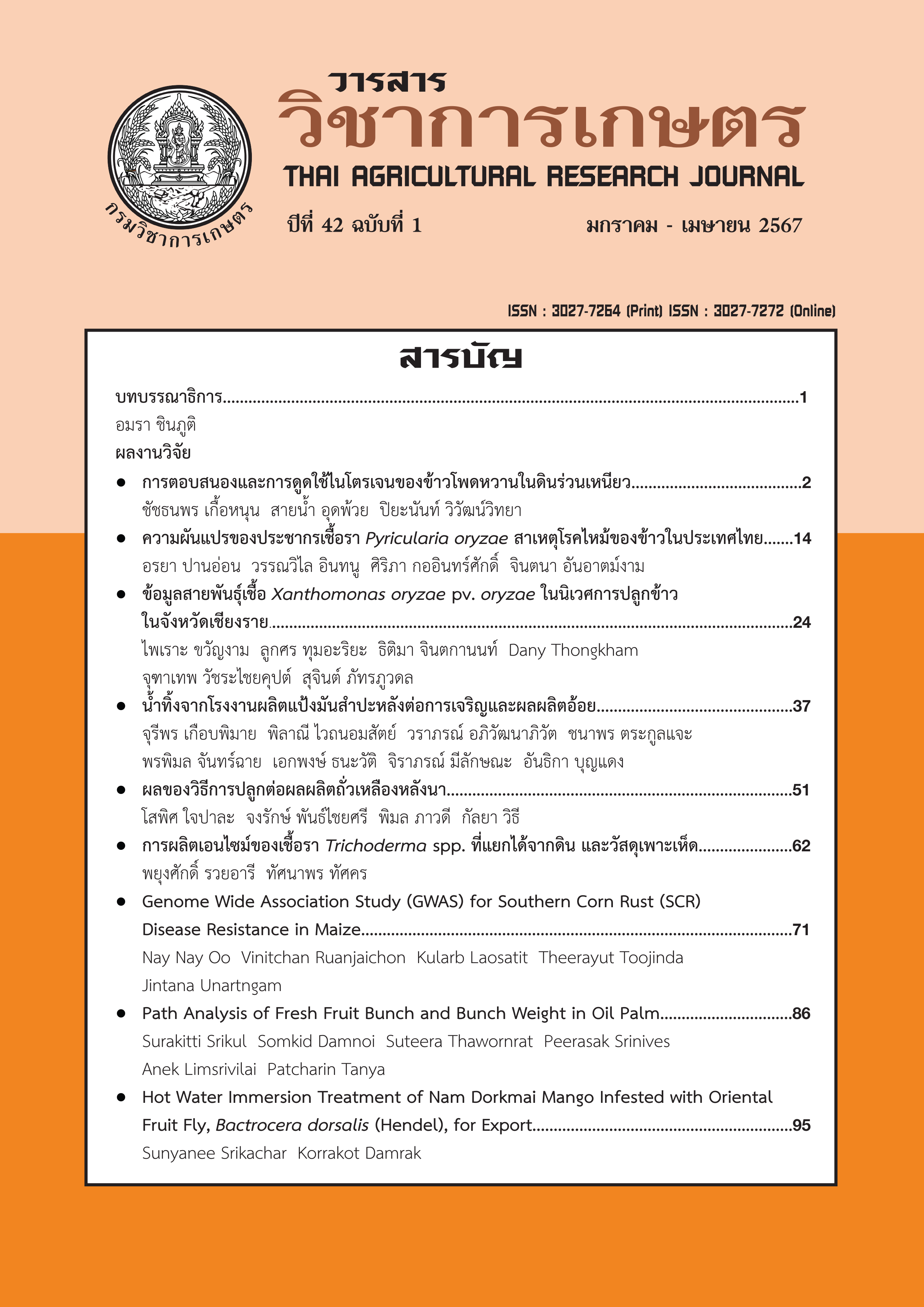น้ำทิ้งจากโรงงานผลิตแป้งมันสำปะหลังต่อการเจริญและผลผลิตอ้อย
DOI:
https://doi.org/10.14456/thaidoa-agres.2024.4คำสำคัญ:
น้ำทิ้งจากโรงงานอุตสาหกรรมแป้งมันสำปะหลัง, ธาตุอาหาร, โลหะหนัก, อ้อย, องค์ประกอบผลผลิตบทคัดย่อ
จากวิกฤติภัยแล้งของประเทศไทย ที่เริ่มทวีความรุนแรงตั้งแต่ปลายปี พ.ศ.2562 อย่างต่อเนื่อง ส่งผลให้น้ำแห้ง ขาดแคลนใช้อุปโภคและบริโภคในทุก ๆ พื้นที่ ดังนั้น การนำน้ำทิ้งจากภาคอุตสาหกรรมมาใช้ประโยชน์ จึงเป็นแนวทางหนึ่งในการแก้ไขปัญหาภัยแล้ง งานวิจัยนี้ จึงเป็นการศึกษาผลของการใช้น้ำทิ้งจากโรงงานอุตสาหกรรมแป้งมันสำปะหลังต่อการเจริญเติบโตและผลผลิตอ้อย เปรียบเทียบกับการใช้น้ำผิวดินจากแหล่งน้ำธรรมชาติ และสภาพน้ำฝนตามธรรมชาติ จากการวิเคราะห์คุณภาพน้ำทิ้งจากโรงงานแป้งมันสำปะหลัง พบว่า มีค่าพารามิเตอร์ที่เกินมาตรฐาน คือ ค่าของแข็งแขวนลอย ค่าสารละลายทั้งหมด ค่าบีโอดีและค่าซีโอดี เมื่อนำน้ำทิ้งจากโรงงานแป้งมันสำปะหลังไปใช้ในการปลูกอ้อยพันธุ์ขอนแก่น3 วางแผนทดลองแบบสุ่มในบล็อกสมบูรณ์ จำนวน 4 ซ้ำ ประกอบด้วย 1) ปลูกอ้อยโดยใช้น้ำทิ้งจากโรงงานแป้งมันสำปะหลัง 2) ปลูกอ้อยโดยใช้น้ำผิวดิน 3) ปลูกอ้อยโดยน้ำฝนตามสภาพตามธรรมชาติ (ไม่มีให้น้ำเพิ่ม) มีการให้น้ำทุก 7 วัน ตามคู่มือการปฏิบัติงานด้านการคำนวณการใช้น้ำของพืช พบว่า การใช้น้ำทิ้งและน้ำผิวดิน ส่งผลให้การเจริญเติบโตและผลผลิตอ้อย ได้แก่ ความสูง ความยาวปล้อง จำนวนปล้อง/ลำ น้ำหนักสด/ลำอ้อย น้ำหนักสด/ไร่ มีค่าอยู่ในช่วง 257.8-270 ซม. 8.38-8.94 ซม. 26.83-27.08 ปล้อง/ลำ 1.85-1.87 กก./ลำ และ 16.96-17.30 ตัน/ไร่ ตามลำดับ ซึ่งไม่แตกต่างกันอย่างมีนัยสำคัญทางสถิติ ในขณะที่สภาพน้ำตามธรรมชาติต้นอ้อยมีการเจริญเติบโตและให้ผลผลิตน้อยที่สุด ส่วนค่าความหวานของอ้อยของทั้ง 3 กรรมวิธีการทดลองนั้น ไม่แตกต่างกัน (12.38-13.40 องศาบริกซ์) ผลการวิเคราะห์ค่าสารพิษและโลหะหนักต่าง ๆ ทั้งในอ้อยและในดินหลังการเพาะปลูก พบว่า ไม่เกินค่ามาตรฐานที่กำหนด ส่วนการสะสมของธาตุอาหารในดินนั้น พบว่า ทั้ง 3 กรรมวิธีการทดลอง ส่งผลให้มีปริมาณธาตุโพแทสเซียม แคลเซียม แมกนีเซียม แมงกานีส และเหล็กค่อนข้างสูงกว่าก่อนการเพาะปลูก อย่างไรก็ตาม การสะสมของสารตกค้างและโลหะหนักในดิน ขึ้นอยู่กับระยะเวลา จากผลการทดลองพบว่า น้ำทิ้งจากโรงงานอุตสาหกรรมแป้งมันสำปะหลังสามารถนำมาใช้ในการเพาะปลูกได้ โดยไม่ก่อให้เกิดสารตกค้างและโลหะหนักในพืชและในดินในระยะเวลาที่ทดลอง
เอกสารอ้างอิง
กระทรวงอุตสาหกรรม. 2560. ประกาศกระทรวงอุตสาหกรรม เรื่อง กำหนดมาตรฐานควบคุมการระบายน้ำทิ้งจากโรงงาน พ.ศ. 2560. ประกาศ ณ วันที่ 30 พฤษภาคม 2560. ประกาศในราชกิจจานุเบกษา วันที่ 7 มิถุนายน 2560.
กรมควบคุมมลพิษ. 2548. คู่มือปฏิบัติการนักรบสิ่งแวดล้อม. กระทรวงทรัพยากรธรรมชาติและสิ่งแวดล้อมกรุงเทพฯ. 34 หน้า.
กรมควบคุมมลพิษ. 2553. วิธีปฏิบัติสำหรับการเก็บตัวอย่างน้ำจากแหล่งน้ำ. กระทรวงทรัพยากรธรรมชาติและสิ่งแวดล้อม กรุงเทพฯ. 58 หน้า.
กรมชลประทาน. 2554. คู่มือการหาปริมาณการใช้น้ำของพืช. แหล่งข้อมูล: http://kmcenter.rid.go.th/kchydhome/documents/2554/manual/Manual_07.pdf.,1. สืบค้น: 1 กุมภาพันธ์ 2564.
กรมวิชาการเกษตร. 2548. คำแนะนำการใช้ปุ๋ยกับพืชเศรษฐกิจ. เอกสารวิชาการ กรมวิชาการเกษตร กระทรวงเกษตรและสหกรณ์, กรุงเทพฯ. 121 หน้า.
กรมวิชาการเกษตร. 2550. ระดับเกณฑ์พื้นฐานของโลหะหนักในดิน และค่าสูงสุดของโลหะหนัก. กรมวิชาการเกษตร กระทรวงเกษตรและสหกรณ์, กรุงเทพฯ.
กรมพัฒนาที่ดิน. 2547. คู่มือการวิเคราะห์ตัวอย่างดิน น้ำ ปุ๋ย พืช วัสดุปรับปรุงดิน และการวิเคราะห์เพื่อตรวจรับรองมาตรฐานสินค้า เล่ม 1. สำนักวิทยาศาสตร์เพื่อการพัฒนาที่ดิน. กรุงเทพฯ. 184 หน้า.
กรมโรงงานอุตสาหกรรม 2563. อุตสาหกรรมแป้งมันสำปะหลัง. แหล่งข้อมูล: http://www2.diw.go.th/I_Standard/Web/pane_files/Industry2.asp. สืบค้น: 3 กุมภาพันธ์ 2564.
คณะกรรมการสิ่งแวดล้อมแห่งชาติ. 2564. ประกาศคณะกรรมการสิ่งแวดล้อมแห่งชาติ เรื่อง กำหนดมาตรฐานคุณภาพดิน พ.ศ. 2564. ประกาศ ณ วันที่ 6 มกราคม พ.ศ. 2564. ประกาศในราชกิจจานุเบกษา วันที่ 11 มีนาคม 2564.
เบญจภรณ์ ประภักดี และจิรวีฐ์ แสงทอง. 2559. แนวทางการฟื้นฟูพื้นที่ปนเปื้อนแคดเมียมด้วยวิธีที่เป็นมิตรกับสิ่งแวดล้อม จากขวดทดลองสู่พื้นที่จริง. วารสารสิ่งแวดล้อม. 20(1): 1-13.
ประเสริฐ ฉัตรวชิระวงษ์. 2542. อ้อย. หน้า 270-295. ใน: พืชเศรษฐกิจ. ภาควิชาพืชไร่นา มหาวิทยาลัยเกษตรศาสตร์, กรุงเทพฯ.
เมธา จันทร์ชื่น สุรศักดิ์ จอนเจิดสิน และสุทธิวรรณ สุทธิสงค์.2536. การออกแบบแปลงให้น้ำสำหรับพืชไร่. โครงงานวิทยานิพนธ์ชลประทาน. มหาวิทยาลัยเกษตรศาสตร์.
สุดชล วุ้นประเสริฐ และธีรยุทธ เกิดไทย. 2558. การจัดการดินและน้ำเพื่อเพิ่มผลผลิตอ้อยตอ ในภาคตะวันออกเฉียงเหนือ. ใน: รายงานการวิจัย สาขาวิชาเทคโนโลยีการผลิตพืช สำนักวิชาเทคโนโลยีการเกษตร. มหาวิทยาลัยเทคโนโลยีสุรนารี. 48 หน้า.
โสภิดา บุญเอนกทรัพย์. 2541. การศึกษาคุณสมบัติน้ำทิ้งในขั้นตอนกระบวนการผลิตแป้งมันสำปะหลัง.หน้า 818-819. ใน: การประชุมทางวิทยาศาสตร์และเทคโนโลยีเพื่อการพัฒนาเศรษฐกิจ ครั้งที่ 24. ณ ศูนย์ประชุมแห่งชาติสิริกิติ์ กรุงเทพฯ.
สำนักข่าวกรมประชาสัมพันธ์. 2565. ชาวไร่อ้อยได้ เฮ! อีกครั้ง หลังรัฐสนับสนุนการเข้าถึงเงินทุนในการพัฒนาการทำเกษตร. แหล่งข้อมูล: https://thainews.prd.go.th/th/news/detail/TCATG220605145744588. สืบค้น: 5 กุมภาพันธ์ 2566.
อาทิตย์ หลอกลาง. 2559. การใช้ประโยชน์น้ำเสียจากโรงงานแป้งมันสำปะหลังสำหรับปลูกหญ้าเนเปียร์ในพื้นที่ดินเค็ม. วารสารราชภัฏธนบุรี. 2: 7-22.
Ayers, R.S. and D.W. Westcot. 1985. Water quality for agriculture. Food and Agriculture Organization of the United Nations, Rome. 174 p.
CEC (Commission of the European Communities). 1993. Withdrawal of certain proposal and drafts from the Commission to the Council (93/C 228/04). Office Journal of the European Communities No. C 228/13.
Iwai, C.B., M. Ta-Oun and N. Barry. 2015. Reuse of wastewater from cassava industry for Napier grass production. International Journal of Environmental and Rural Development. 6(2): 42-47.
Pierzynski, M., J.T. Sims and G.F. Vance. 2000. Soil phosphorus and environmental quality. pp 155-207. In: Soils and Environmental Quality, CRC Press, Boca Raton, USA.
Sánchez, M., O.G. Gonzalo, S. Yáñez, I. Ruiz and M. Soto. 2021. Influence of nutrients and pH on the efficiency of vertical flow constructed wetlands treating winery wastewater. Journal of Water Process Engineering. 42: 102103.
Setyawaty, R., K. Katayama-Hirayama, H. Kaneko and K. Hirayama. 2011. Current tapioca starch wastewater (TSW) management in Indonesia. World Applied Science Journal. 14(5): 658-665.
Zhou, C., S. Xu, M. Zhang, Y. Chen, X. Guan, S. Wu, Z. Bai. 2012. Utilization of sweet potato starch wastewater for biofertilizer production by Bacillus amyloliquefaciens. pp. 237. In: WIT Press. Dec. 11, 2012. Southampton, United Kingdom.
ดาวน์โหลด
เผยแพร่แล้ว
รูปแบบการอ้างอิง
ฉบับ
ประเภทบทความ
สัญญาอนุญาต
ลิขสิทธิ์ (c) 2024 วารสารวิชาการเกษตร

อนุญาตภายใต้เงื่อนไข Creative Commons Attribution-NonCommercial-NoDerivatives 4.0 International License.
วารสารวิชาการเกษตร



